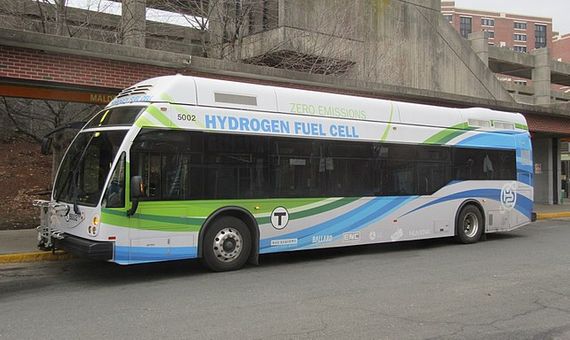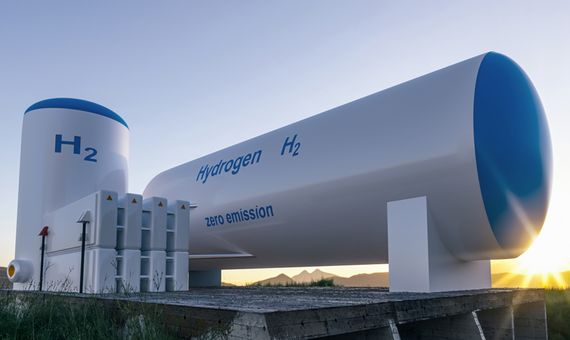It is one of the magic words in the fight against climate change: hydrogen. This colourless, odourless and non-toxic gas—although highly flammable, as the Hindenburg airship disaster of 1937 attests—is a very minor component of the atmosphere, as the vast majority of the Earth’s hydrogen is in the form of water and organic molecules. Hydrogen today holds great promise for clean energy as an alternative to fossil fuels: virtually inexhaustible, its combustion produces only water, with zero emissions. But what sounds too good to be true usually has a downside, and hydrogen also comes with some fine print: scientists have been warning for years that it can indirectly aggravate climate change. Now they are also warning that its presence in the atmosphere has skyrocketed, perhaps precisely because of its use as an energy source.

Although interest in hydrogen (H2) as a fuel has escalated in parallel with growing concern about climate change, the foundations of the technology date back more than two centuries. Electrolysis of water—breaking it down by electricity to separate its two elements—was first achieved in the late 18th and early 19th centuries. Having thus obtained hydrogen as a raw material, in 1838 the German-Swiss chemist Christian Friedrich Schönbein and the British scientist William Robert Grove demonstrated the reverse path, the principle of the hydrogen fuel cell, combining it with oxygen to produce water and electricity. While the use of hydrogen was still a century away, in 1875 the visionary Jules Verne prophesied its future as a fuel in his novel The Mysterious Island.
The B-side of the hydrogen economy
It was in 1932 that the English engineer Francis Thomas Bacon built the first practical system, which served no less a purpose than helping to take the Apollo astronauts to the moon. Since then and up to the present day, this technology has progressed, generating different types of fuel cells. In addition, hydrogen can also be used directly in combustion engines without generating CO2. In the automotive industry, hydrogen also offers a particular advantage over electric batteries in the case of heavy-duty vehicles.
However, hydrogen is a complex world in which all that glitters is not gold. Different production sources have given rise to a colour code. So-called “green” hydrogen is produced by the electrolysis of water powered by renewable energies. But this ideal method is expensive, so the vast majority of hydrogen produced in the world today is made by a cheaper process called steam reforming, which uses natural gas as a feedstock and does generate CO2 from the reaction of methane with water. This is “grey” hydrogen, which does not contribute to the mitigation of climate change. However, grey hydrogen can be transformed into “blue” hydrogen when the CO2 generated is captured by carbon storage technologies (CCUS), although there are doubts among experts not only about the viability of these systems, but also about how green so-called blue hydrogen can be.
Currently only 2% of the world’s hydrogen is green, but only 0.1% comes from dedicated water electrolysis; the rest is created as a by-product of industrial processes such as the production of chlorine and caustic soda. Although hydrogen remains a minor energy source, there has been widespread interest for years in driving the transition to a hydrogen economy to decarbonise those activities and sectors where electrification as an alternative to fossil fuels is difficult to implement. Countries such as the US, Canada, the UK, Germany, Australia, Japan, South Korea and the European Union as a whole have enacted energy strategies for the deployment of green hydrogen. According to the Hydrogen Council—a conglomerate of companies in the sector—by 2050 hydrogen will be able to supply more than 20% of global energy demand, which will prevent the cumulative emission of 80 gigatonnes of CO2.
A potential contributor to the greenhouse effect
But in addition to the fact that the hydrogen economy still has many technical hurdles to overcome, there is a further problem. “We think H2 has an indirect warming effect by affecting OH [hydroxyl radicals], the main sink for methane, and hence the lifetime of methane,” David Stevenson, an atmospheric chemist at the University of Edinburgh, summarises to OpenMind. In 2006, Stevenson and his colleagues raised the alarm by warning that atmospheric hydrogen sequesters these hydroxyl radicals that are normally responsible for the removal of methane, the second most important greenhouse gas (GHG), 28 times more potent than CO2 over a 100-year time horizon. And if hydroxyl radicals decrease, methane lasts longer in the atmosphere.
On top of this, “there may also be a change in tropospheric ozone associated with hydrogen which may add to the indirect warming effect of methane changes, and that is also associated with the reaction of hydrogen with OH,” Hannah Bryant, a PhD student of Stevenson’s who focuses her work on the atmospheric and environmental effects of hydrogen, tells OpenMind. Ozone is the third most important GHG. But there is yet more interference when hydrogen combines with oxygen in the stratosphere to form water vapour, which also contributes to global warming. “A future hydrogen economy would therefore have greenhouse consequences and would not be free from climate perturbations,” wrote Stevenson and her collaborators in 2006.

As for how much indirect warming potential hydrogen may have, models run by Stevenson and other researchers estimate that it may be five times greater than that of CO2 over a 100-year time horizon. But they warn that uncertainties remain. “We are currently quure of the environmental consequences of adding more H2 to the atmosphere,” says Stevenson. “All these effects are probably quite small, but will scale with the size of the perturbation to H2.” The problem, Bryant adds, is that unlike CO2 or methane, which have been tite unshe main focus of climate change research, “the budget of hydrogen in the atmosphere—the relative sizes of the sources and sinks—is currently poorly constrained, primarily due to uncertainties in the main sink, deposition to the soil. This makes it difficult to assess the consequences of H2.”
Stevenson has been joined by a number of other experts who warn of the double-edged sword that an expansion of the hydrogen economy could be in terms of climate change. In statements to the European agency Euractiv, the chief scientist at the US-based NGO Environmental Defense Fund (EDF) and member of the United Nations Intergovernmental Panel on Climate Change (IPCC), biogeochemical ecologist Steven Hamburg, calculated that hydrogen is 200 times more potent as a GHG than CO2 in the short term, at the time it is released. Climate scientist Ilisa Ocko, also of the EDF, warned that hydrogen could undermine the climate benefits of decarbonisation efforts.
Leaks, the worst enemy of the use of hydrogen
But how is it possible that even green hydrogen could lead to such undesirable consequences? The answer can be summed up in one word: leakage. The entire process of hydrogen production, transport, distribution, storage and use is affected by potential leaks that release the gas into the atmosphere. Such leaks are common; in the case of blue hydrogen, the leakage of the methane used to produce it is considered its main drawback. But regardless of hydrogen’s colour, hydrogen leaks themselves are the biggest threat to its expansion as an energy source. As with the hydrogen budget, Bryant stresses that the extent of leakage is still an unknown and subject to estimation. But “if leakage rates are high, or the H2 economy becomes very large, they may become important,” says Stevenson.

And the data says this is already occurring; a study led by the University of California at Irvine has analysed the air trapped in Antarctic ice over the past 150 years. “We find a roughly 70% rise in atmospheric H2 over the twentieth century that can be attributed to human activities,” the researchers write; and they note that while fossil fuel burning was thought to be a major source of hydrogen emissions, in fact the stricter automobile pollution regulations introduced in the late 20th century have not reduced H2 levels. “It is likely that nonautomotive anthropogenic H2 emissions have been underestimated,” the authors conclude, and point to one cause: leakage. Controlling this factor by creating a perfectly sealed green hydrogen network may be the key to realising the promise of this gas.
Comments on this publication